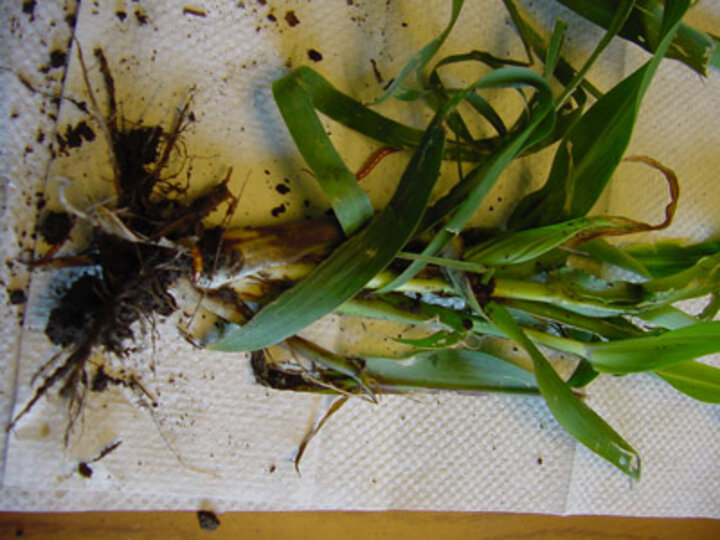June 27, 2008

|
|
Wirewowrm damage to corn in Lancaster County, in a field where seed wasn't treated and there was a high percentage of infestation. The field was replanted. (Photo by Keith Glewen) Bob Wright, Extension Entomologist, notes: Wireworms damage relatively few fields in Nebraska, but where they are abundant they can cause significant injury to seedling corn. The cool wet weather this spring extended the period of time that seeds and seedlings were in stages susceptible to wireworm injury. The lack of a planting time insecticide in this case resulted in significant injury. |
Randy Pryor, Extension Educator in Saline County: Crop diseases are taking a toll on the southeast Nebraska wheat crop. In Saline County fusarium wheat scab is very prevalent. Scab was identified throughout the UNL variety test plot near Western in Saline County. The cooperator's field was showing at least 20% scab symptoms in a field adjacent to the UNL wheat variety plots. Septoria caused leaf losses, especially in certain varieties such as 2137. It is rare to see this disease cause problems on flag leaves like it did this year. "Rain on the Plains" was not good for southeast Nebraska wheat during pollination. Fungal diseases will negatively impact yield, the extent we do not know yet.
Douglas L Anderson, Extension Educator in Keith, Arthur, and Perkins counties: Corn plants are finally growing with some sunshine and heat units. Wheat is just starting to turn and harvest is estimated for the week after the Fourth of July. A few soybeans are up and growing. A few pastures are green but growing slowly, and most have major weed pressure. Some fields have changed from corn to beans to forage. A seed shortage as well as hard rains in some areas seem to be contributing to replanting problems. Perkins and Chase counties have had some hail and there may be some replanting.
Ron Seymour, Extension Educator in Adams County: Corn plants are in the 6- to 8-leaf stage. Many people are completing cultivation and hilling procedures. There have been some reports of hail damage in the Trumbull and Pauline areas, but in general, the corn crop is in good condition. Soybean plant growth stages are variable. Early planted fields are in the two trifoliate stage. Later planted fields are in the cotyledon stage. A number of fields have yet to be planted because of excess water. Wheat is turning color and starting to ripen. In general, the crop looks good but I have noticed some lodging due to excess rainfall. Most of the first alfalfa cutting is completed and the second cutting is growing well. Most cool season pastures look very good and the grasses are blooming.
Duane A. Lienemann, Extension Educator in Webster and Clay counties: Last week about 90-120 square miles of crops on the eastern half of Webster County was hit with severe wind, thunderstorms and hail. The destruction started near Ayr to Pauline on Highway 74 and then headed south by southwest across the sections in southern Adams County all the way across about a three- to four-mile line through Webster County all the way to the Kansas border. The worst damage was east of Blue Hill and east of Cowles with hot spots scattered throughout. Damage varied from total loss to some that will make it. Several wheat fields looked like they had been harvested, and some corn and soybean fields didn't look like they had been planted or if they had, they had been planted to stalks. This storm damage was magnified when another storm with hail came through a week later. Some of the same fields were hit as well as some additional ones. Crops not affected by the storms are starting to really grow, but we are behind by about two weeks in growing stages in most every crop.
Some corn fields were replanted or replaced with grain sorghum and most of the soybeans were planted back to beans and are coming up. Most fields with slight to moderate damage are starting to grow out of it. I am concerned about the bruises on the sides of corn plants in fields that were counted as moderate damage and left as is. Wheat fields that were hit hard have been swathed (with what was there) and put up for hay, and some have been planted to beans or grain sorghum in the remaining stubble. Wheat is still at least a week away from harvest, but is turning rapidly.
Prior to that the only potential problem was that a lot of wheat was exhibiting fusarium head blight ranging from 5% to 75% infection. Most everyone had sprayed for rust so most fields were relatively clean from rust, with some Septoria being exhibited. Stephen Wegulo, UNL plant pathologist, and I scouted fields from northern Kansas to Adams County and every field we looked at had varying degrees of scab.
